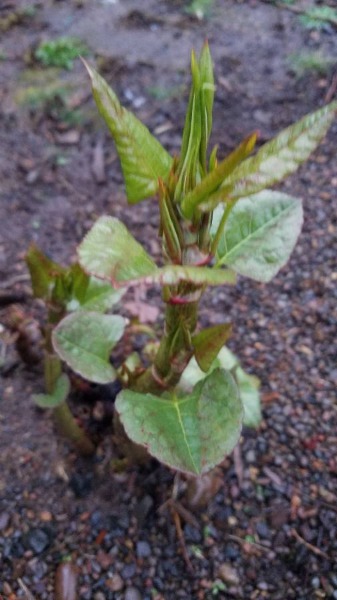Japanese Knotweed (Fallopia japonica) on Mar 30, 2020
Submitter has sample
EDRR Status: Local expert notified
Description of specimen
Several NEW STARTS popping up



I am so sorry to hear of your predicament. I am afraid there is no easy solution. Japanese knotweed is notoriously difficult to control, and approaching your neighbors can be a challenge deepening on so many factors.
In terms of manual knotweed control you must have persistence and patience. It can require digging it out to 10 ft depth, and then plan to monitor the site and dig out any starts for up to 10 years. It also helps to cover the where you excavated with thick black plastic or multiple layers of cardboard, and extending at least 2 feet beyond the original infestation.
It is very important to dispose of all plant material properly. Unless you can be 100% confident that you can kill the plant by drying in the sun or fully composing, then I would take the knotweed material to the dump. Don’t put it in the yard waste as this might be further spreading it to other people.
The most effective treatment options have combined manual control with limited and strategically timed herbicide application. For example, one option is to cut back the knotweed in mid summer, then when the plant regrows to about knee-high, you can apply glyphosate very carefully according the label instructions. Being low to the ground reduces any drift so you can minimize the effect on other plants and insects. Also, later in the summer/fall, knotweed begins to re-sequester its nutrients back into the roots so that the herbicide is even more effective. It is critical of course that you follow the herbicide label instructions.
One option might be to simply do nothing and choose a different site for your greenhouse. It is best to not try to control it if you are not in it for the long term. Agitating the plant will only cause it to grow more vigorously. The knotweed patch might not expand that much if you just let it be (but no promises on that!).
I would be cautious about building a structure on or near an infestation of knotweed unless you have a very solid foundation since knotweed has been known to permeate pavement and destroy parking lots. This might be extreme, but perhaps sinking an underground cement barrier 10 ft deep between your property at the greenhouse and your neighbors it could stop the knotweed from getting to your greenhouse.
Maybe you can work together with your neighbor to rent a back-hoe to excavate the site, then they could allow you to enter their property to monitor for sprouts every year? That would probably the most permanent solution, but also expensive, and require good diplomacy.
Here are some links for knotweed control.
https://www.invasive.org/gist/moredocs/polspp01.pdf
https://www.nrcs.usda.gov/Internet/FSE_DOCUMENTS/stelprdb1081649.pdf
I am very sorry to be the bearer of such bad news! Take care, good luck, and let me know how it goes
Sincerely,
Tania
PS: Did you know the economic impacts of knotweed have been so profound that in the UK people can be held liable if knotweed on their property affects another persons property. (https://www.japaneseknotweed.co.uk/knotweed-and-the-law)
Tania Siemens (she/her/hers)
Research Coordinator
Don't Pack a Pest for Academic Travelers
Oregon Sea Grant
Oregon State University
cell: 541-914-0701 email: tania.siemens@oregonstate.edu
https://seagrant.oregonstate.edu/outreach-and-engagement/invasive-species/dont-pack-a-past-student-travelers
Tania Siemens
April 6, 2020, 12:45 a.m.